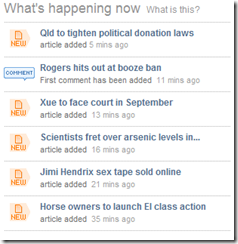As I posted earlier, I am going to be posting my book outline in parts to my blog to get feedback and Ideas - please feel free to chime in! Except from “Revolution of Me” - A book outline by Chris Saad
OVERVIEW
In recent years The revolution of Me has increased in tone and tempo as new technologies help us to better visualize and broaden our human scale network. Technology is actually a key driver of disintegration.
Technology allows us to find and communicate with more people at once. It helps us to reduce the cost of distribution to, in some cases, zero. It helps us bypass mediators and magnify the once insignificant to make it (seem?) profound. It helps us to visualize broad patterns and it can also cause us to lose ourselves in the noise.
In effect, technology has changed our perception of things while also giving us the power to far exceed our grasp. With this new found power, we find new economies of scale that diminish the need for our containers and enable greater personalization.
Continuing with the examples of Marriage and Music; We now have access to more potential mates, more potential temptations, more potential opportunities for travel, more work pressures and more distractions than ever before. Our exposure to more content and greater voyeuristic insight into other people’s lives has demystified our social structures to the point where people feel overwhelmed with choices for a partner, more distracted by travel, work and entertainment and more aware of how taboos and social conventions don’t always apply.
In addition to these the social changes, technology simply allows us to be in close contact from greater distances. The idea that people had to live in the same home in order to nurture and connect to each other is losing value for many. The result is an almost global selection pool.
Music has been affected by technology in other ways. It is now economically feasible to distribute music at almost no cost. The cost of a single download pales in comparison to shelf space in a record store, packaging, shipping and materials. Music production has also decreased in cost dramatically to the point where anyone with a computer can make a song. With the barrier to entry, production and distribution reduced to next to nothing record labels are being forced to compete in other ways.
Shipping individual songs electronically now costs the same as shipping the whole album. With access to more customers, artists and record companies are forced to cater more to individual tastes of audiences who now except to pay only for what they love. And there is no shortage of music to choose from.
So as we see in these two very different examples, technology has had a profound effect in creating a personalization revolution.
It is important to note that, in this text, I do not propose to pass judgment on the trends, only highlight them. For some, the breakdown of the family container of Marriage may be horrifying. There may be plenty of psychological, spiritual or economic reasons why this trend is not constructive for society. Or maybe not. This does not change the reality that the trend is indeed occurring.
What follows is a more detailed exploration of these two examples, as well as many others in the areas of Media, Business, Politics, Family and War.
Comments, ideas and contributions welcome!





